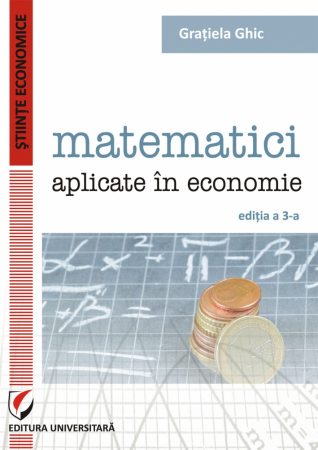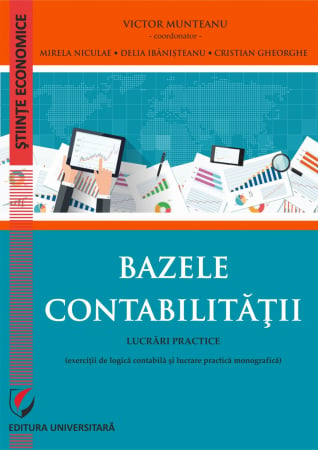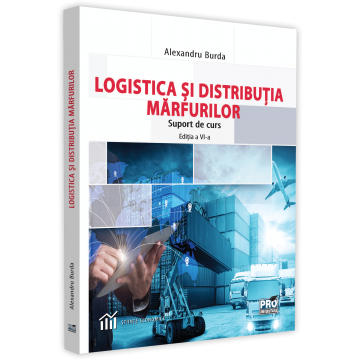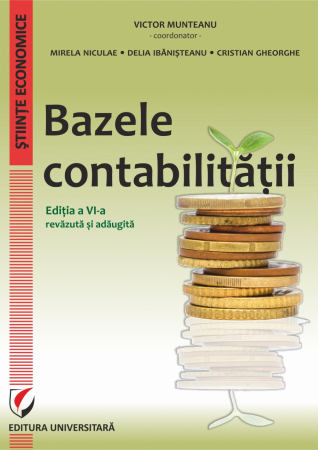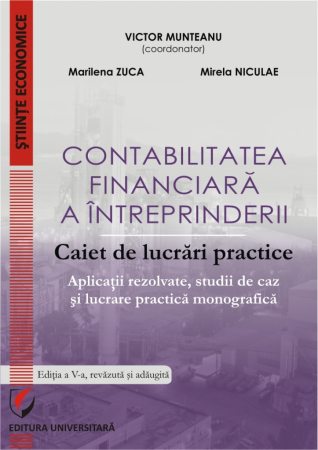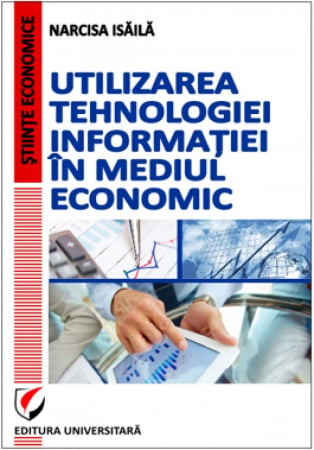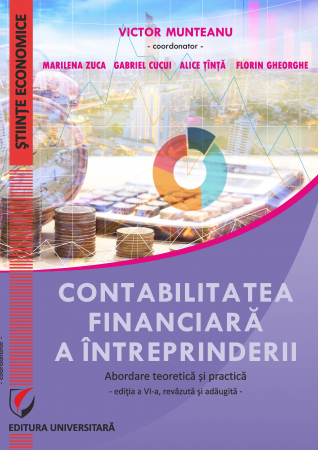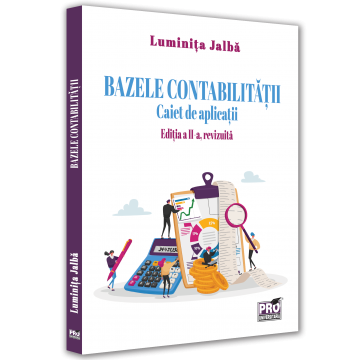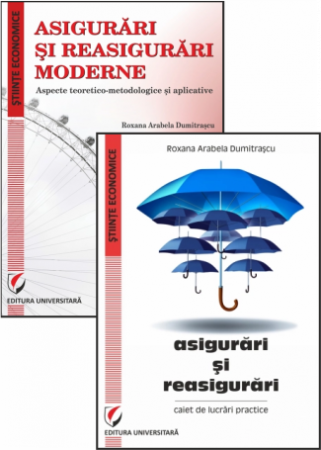Manuscript proposals: [email protected] / 0745 204 115 //// Tracking orders Individuals / Sales: 0745 200 357 / Orders Legal entities: 0721 722 783
ISBN: 978-606-28-0826-6
DOI: 10.5682/9786062808266
Publisher year: 2018
Edition: I
Pages: 118
Publisher: Editura Universitară
Author: Oana Mionel
Product Code:
9786062808266
Do you need help?
0745 200 357
- Description
- Download (1)
- Authors
- Content
- More details
- Reviews (0)
At the origin of what we call today commodity exchanges or stock exchanges / financial markets are the places where real and financial products were exchanged in the past. The oldest example of the organized market of financial securities can be found in Rome in the second century AD.
trading in Rome was the Romanian Forum described by the Russian historian Mikhail Rostovtzeff (1870 - 1952) as follows: “a lot of people who buy and sell shares and bonds of tax collection companies, various goods on money or credit, agricultural farms and real estate Italy and in the provinces, houses and shops in Rome, ships, warehouses, slaves and cattle ”. However, the name of the stock exchange term (XIII - XIV centuries) seems to come from the name of an old family of innkeepers van der Buerse (from Bruges - Belgium) who founded a place called Hotel des Buerse in the lobby of which they were negotiating. precious metals (gold, silver, platinum), as well as valuables.
Royal Exchange, London. In the 16th century, London was an important commercial center. Traders from all over Europe came to London to sell their goods through shops, houses, taverns and even on the street. To eliminate the random sale of goods, Sir Thomas Gresham built the Royal Exchange (1565-1567) as an organized and regulated institution where merchants and bankers could meet and sell goods.
Amsterdam Stock Exchange (1602). The Amsterdam Stock Exchange - now known as Euronext Amsterdam - is considered to be the oldest stock exchange in the Netherlands and the first to introduce continuous trading. The first company to issue and trade shares and bonds on the Amsterdam Stock Exchange was the Dutch East India Company, whose business was based on the marketing of spices brought from Asia. The increase of the share capital determined the company to sell shares to the public and to accept the new shareholders as part of the business.
Tulipomania (1630 - 1637). Tulip mania or tulip madness had its epicenter in the Netherlands (Amsterdam) or as it is now known as Tulip Country. The economic and cultural development of the Netherlands since the seventeenth century (a situation that continues today) laid the foundations for the creation of financial instruments whose innovation continues today. Brought from Turkey in 1593 by a well-known European botanist (Charles de l'Écluse) of that time, the tulip began to become for the Dutch the favorite flower and emblem of social status, causing those who loved this flower to create even a tulip tree. in which the tulips are arranged so that each flower is noticed.
The passage of time has caused this passion for tulips to turn into a rage for these flowers. The triggering moment was when a new variety of tulips (Viceregele or Semper Augustus) appeared on the market, red with white or red with yellow, the main cause of the appearance being a plant virus. Therefore, this type of tulip was much more difficult to obtain, thus giving it a rarity and a much higher price. They appeared on the market together with beauty lovers and simple investors who wanted to make financial speculations with this commodity. The hypotheses that tried to explain the collapse of the tulip market in 1637 are multiple: from the existence of a speculative bubble that at some point must break and to the presentation of the situation in which the Dutch parliament changed the legislation on contracts of sale - purchase of tulip bulbs. . Until the date of the change of legislation, there were forward sale-purchase contracts, contracts which provided that the buyer was obliged to buy the goods at the established term and at the established price regardless of the price fluctuations existing in the market. After the change took place, the futures contracts were transformed into option contracts which provided that the buyer had the right, but not the obligation, to purchase the goods at the established price and in exchange for a premium paid.
At the end of 1636, when investors in tulip bulb transactions found out about the legislative changes that were to take place, it is believed that this gave a boost to transactions (people rushed to do business with tulips as much as they could, causing thus an increase in prices). Changing regulations has made such investments risky in the future; therefore, in February 1637, those who had bulbs for sale could no longer find buyers willing to pay the high prices demanded, and at that time the market collapsed, prices falling sharply.
History of Wall Street (1653) and the New York Stock Exchange (1789). When we hear the words Wall Street, the thought immediately leads us to the STOCK EXCHANGE and the artery on which the world's largest stock exchange companies and financial institutions have concentrated over time. Where the United States now existed, in the seventeenth century there were nine colonies English and a Dutch one called New Netherland. It included a Manhattan island with a small New Amsterdam settlement of about 300 inhabitants whose main occupation was cattle raising (over time, New Amsterdam developed and became a mega-metropolis). In 1644, a large Dutch trading company based in New Amsterdam wanted to stop the unhindered movement of cattle through the island and requested the erection of a fence in a well-established perimeter where residents could keep their cattle. A few years later, in 1653, New Amsterdam was occupied by the English. Once occupied, the English wanted to change its name, giving it a local name related to the old homeland, England and the new word. In the end, someone from Yorkshire said "York" plus the word "new" came from New York. The second change desired by the English was to demolish the fence. The dismantling of the fence being much too complicated, requiring a lot of labor, it was agreed to set it on fire. Everything burned around him except for one alley that surrounded him and was called "Wall Street" or the English name "Wall Street".
The New York Stock Exchange (NYSE) was born in 1789, when Congress took over the debts of the new colonies and the government by issuing so-called "government notes," creating a new type of investment instrument whose name would be securities (shares - parts of a company's property and bonds or bonds - debt agreement). Also during this period, new traders appeared who sold and bought these securities; they have been called brokers or brokers or stockbrokers, and the company in which they will work will be called a brokerage company or furniture brokerage agency. The transactions took place every day under the sycamore at number 68-70 on Wall Street (now considered the ancestor of the stock exchange ring), because in 1792, 24 brokers signed an agreement of the brokers by which they created at that time the first stock exchange. organized in New York. In 1870, the NYSE moved to a new location (also on Wall Street) where it still operates today. The beginning and the end of a trading day were marked by a gong - a tradition that is still preserved today - later adopted by all securities markets. If when there were only a few securities traded, brokers could retain "closing prices" and start the day with "opening prices", over time, the number of securities traded increased, as well as that of clients and brokers, becoming increasingly difficult to retain prices for all securities. Thus, it was agreed that for each title the following data must be retained:
• The full name of the traded security;
• The abbreviated name of the traded security (called a symbol or ticker);
• Number of transactions made (volume);
• The highest daytime price of the title (high);
• The lowest price per day (low);
• “Closing price” (close);
• “Opening price” (the price at which the transaction started - open);
• The price of the last overnight transaction (logically it should be equal to the closing price, but it may be different if the stock exchange accepts transactions after closing, this activity being called after hours trading);
• By what percentage did the price of a security decrease or increase (%);
• How much the price of a security (change) has decreased or increased algebraically.
All this information was written on slate tablets considered small, light and very easy to erase, so that what was not interesting to disappear and remain only the information
"Precious."
Chicago Board of Trade (CBOT - 1848). CBOT is the first stock exchange in the world where standardized futures contracts were traded, being called futures contracts. These contracts standardized: grain quality, grain quantity, time and place for grain delivery. The price in futures contracts was open to trading in the stock market. These grain futures were the basis for the financial and commodity futures contracts in use today.
Tokyo Stock Exchange (1878). The Tokyo Stock Exchange was created in 1878, when a system of financial securities was established and the first public negotiation of bonds began. Later, between August 10, 1945 and April 1, 1949, official trading was stopped due to the war. After several years of necessary reorganizations in the stock market after the war, Tokyo Stock Exchange became the most important stock exchange in the group of five Japanese stock exchanges: Sapporo Securities Exchange, Osaka Securities Exchange, Nagoya Stock Exchange, Fukuoka Stock Exchange, Tokyo Stock Exchange. In 1969, TSE introduced TOPIX (Tokyo Stock Price Index) which is a cotax on all common shares listed on the stock exchange. TOPIX is considered the best indicator of financial conditions on the Japanese stock market8.
New York Mercantile Exchange (1872). Initially, the stock market had very modest ambitions, illustrating the ambitions of sixty-two New York traders looking for a place to sell dairy products. The original name of NYMEX was "Butter and Cheese Exchange". Over time, eggs were added to the menu, and in 1880 the name was changed to "Egg, Butter and Cheese Exchange". In 1882 a new name change followed, and the stock exchange became the "New York Commodity Exchange." In 1992, quotations were introduced for eggs that were traded right next to the eggs. Over time, other products such as Maine potatoes, onion varieties, apples (McIntosh and Golden), Idaho potatoes, cork and platinum have been listed. But on March 30, 1983, the most important innovation took place, the stock exchange introduced forward transactions for crude oil.
trading in Rome was the Romanian Forum described by the Russian historian Mikhail Rostovtzeff (1870 - 1952) as follows: “a lot of people who buy and sell shares and bonds of tax collection companies, various goods on money or credit, agricultural farms and real estate Italy and in the provinces, houses and shops in Rome, ships, warehouses, slaves and cattle ”. However, the name of the stock exchange term (XIII - XIV centuries) seems to come from the name of an old family of innkeepers van der Buerse (from Bruges - Belgium) who founded a place called Hotel des Buerse in the lobby of which they were negotiating. precious metals (gold, silver, platinum), as well as valuables.
Royal Exchange, London. In the 16th century, London was an important commercial center. Traders from all over Europe came to London to sell their goods through shops, houses, taverns and even on the street. To eliminate the random sale of goods, Sir Thomas Gresham built the Royal Exchange (1565-1567) as an organized and regulated institution where merchants and bankers could meet and sell goods.
Amsterdam Stock Exchange (1602). The Amsterdam Stock Exchange - now known as Euronext Amsterdam - is considered to be the oldest stock exchange in the Netherlands and the first to introduce continuous trading. The first company to issue and trade shares and bonds on the Amsterdam Stock Exchange was the Dutch East India Company, whose business was based on the marketing of spices brought from Asia. The increase of the share capital determined the company to sell shares to the public and to accept the new shareholders as part of the business.
Tulipomania (1630 - 1637). Tulip mania or tulip madness had its epicenter in the Netherlands (Amsterdam) or as it is now known as Tulip Country. The economic and cultural development of the Netherlands since the seventeenth century (a situation that continues today) laid the foundations for the creation of financial instruments whose innovation continues today. Brought from Turkey in 1593 by a well-known European botanist (Charles de l'Écluse) of that time, the tulip began to become for the Dutch the favorite flower and emblem of social status, causing those who loved this flower to create even a tulip tree. in which the tulips are arranged so that each flower is noticed.
The passage of time has caused this passion for tulips to turn into a rage for these flowers. The triggering moment was when a new variety of tulips (Viceregele or Semper Augustus) appeared on the market, red with white or red with yellow, the main cause of the appearance being a plant virus. Therefore, this type of tulip was much more difficult to obtain, thus giving it a rarity and a much higher price. They appeared on the market together with beauty lovers and simple investors who wanted to make financial speculations with this commodity. The hypotheses that tried to explain the collapse of the tulip market in 1637 are multiple: from the existence of a speculative bubble that at some point must break and to the presentation of the situation in which the Dutch parliament changed the legislation on contracts of sale - purchase of tulip bulbs. . Until the date of the change of legislation, there were forward sale-purchase contracts, contracts which provided that the buyer was obliged to buy the goods at the established term and at the established price regardless of the price fluctuations existing in the market. After the change took place, the futures contracts were transformed into option contracts which provided that the buyer had the right, but not the obligation, to purchase the goods at the established price and in exchange for a premium paid.
At the end of 1636, when investors in tulip bulb transactions found out about the legislative changes that were to take place, it is believed that this gave a boost to transactions (people rushed to do business with tulips as much as they could, causing thus an increase in prices). Changing regulations has made such investments risky in the future; therefore, in February 1637, those who had bulbs for sale could no longer find buyers willing to pay the high prices demanded, and at that time the market collapsed, prices falling sharply.
History of Wall Street (1653) and the New York Stock Exchange (1789). When we hear the words Wall Street, the thought immediately leads us to the STOCK EXCHANGE and the artery on which the world's largest stock exchange companies and financial institutions have concentrated over time. Where the United States now existed, in the seventeenth century there were nine colonies English and a Dutch one called New Netherland. It included a Manhattan island with a small New Amsterdam settlement of about 300 inhabitants whose main occupation was cattle raising (over time, New Amsterdam developed and became a mega-metropolis). In 1644, a large Dutch trading company based in New Amsterdam wanted to stop the unhindered movement of cattle through the island and requested the erection of a fence in a well-established perimeter where residents could keep their cattle. A few years later, in 1653, New Amsterdam was occupied by the English. Once occupied, the English wanted to change its name, giving it a local name related to the old homeland, England and the new word. In the end, someone from Yorkshire said "York" plus the word "new" came from New York. The second change desired by the English was to demolish the fence. The dismantling of the fence being much too complicated, requiring a lot of labor, it was agreed to set it on fire. Everything burned around him except for one alley that surrounded him and was called "Wall Street" or the English name "Wall Street".
The New York Stock Exchange (NYSE) was born in 1789, when Congress took over the debts of the new colonies and the government by issuing so-called "government notes," creating a new type of investment instrument whose name would be securities (shares - parts of a company's property and bonds or bonds - debt agreement). Also during this period, new traders appeared who sold and bought these securities; they have been called brokers or brokers or stockbrokers, and the company in which they will work will be called a brokerage company or furniture brokerage agency. The transactions took place every day under the sycamore at number 68-70 on Wall Street (now considered the ancestor of the stock exchange ring), because in 1792, 24 brokers signed an agreement of the brokers by which they created at that time the first stock exchange. organized in New York. In 1870, the NYSE moved to a new location (also on Wall Street) where it still operates today. The beginning and the end of a trading day were marked by a gong - a tradition that is still preserved today - later adopted by all securities markets. If when there were only a few securities traded, brokers could retain "closing prices" and start the day with "opening prices", over time, the number of securities traded increased, as well as that of clients and brokers, becoming increasingly difficult to retain prices for all securities. Thus, it was agreed that for each title the following data must be retained:
• The full name of the traded security;
• The abbreviated name of the traded security (called a symbol or ticker);
• Number of transactions made (volume);
• The highest daytime price of the title (high);
• The lowest price per day (low);
• “Closing price” (close);
• “Opening price” (the price at which the transaction started - open);
• The price of the last overnight transaction (logically it should be equal to the closing price, but it may be different if the stock exchange accepts transactions after closing, this activity being called after hours trading);
• By what percentage did the price of a security decrease or increase (%);
• How much the price of a security (change) has decreased or increased algebraically.
All this information was written on slate tablets considered small, light and very easy to erase, so that what was not interesting to disappear and remain only the information
"Precious."
Chicago Board of Trade (CBOT - 1848). CBOT is the first stock exchange in the world where standardized futures contracts were traded, being called futures contracts. These contracts standardized: grain quality, grain quantity, time and place for grain delivery. The price in futures contracts was open to trading in the stock market. These grain futures were the basis for the financial and commodity futures contracts in use today.
Tokyo Stock Exchange (1878). The Tokyo Stock Exchange was created in 1878, when a system of financial securities was established and the first public negotiation of bonds began. Later, between August 10, 1945 and April 1, 1949, official trading was stopped due to the war. After several years of necessary reorganizations in the stock market after the war, Tokyo Stock Exchange became the most important stock exchange in the group of five Japanese stock exchanges: Sapporo Securities Exchange, Osaka Securities Exchange, Nagoya Stock Exchange, Fukuoka Stock Exchange, Tokyo Stock Exchange. In 1969, TSE introduced TOPIX (Tokyo Stock Price Index) which is a cotax on all common shares listed on the stock exchange. TOPIX is considered the best indicator of financial conditions on the Japanese stock market8.
New York Mercantile Exchange (1872). Initially, the stock market had very modest ambitions, illustrating the ambitions of sixty-two New York traders looking for a place to sell dairy products. The original name of NYMEX was "Butter and Cheese Exchange". Over time, eggs were added to the menu, and in 1880 the name was changed to "Egg, Butter and Cheese Exchange". In 1882 a new name change followed, and the stock exchange became the "New York Commodity Exchange." In 1992, quotations were introduced for eggs that were traded right next to the eggs. Over time, other products such as Maine potatoes, onion varieties, apples (McIntosh and Golden), Idaho potatoes, cork and platinum have been listed. But on March 30, 1983, the most important innovation took place, the stock exchange introduced forward transactions for crude oil.
-
Commodity exchanges
Download
OANA MIONEL
Doctor in Economics, awarded by the Academy of Economic Studies and also Associate Professor at the Faculty of International Economic Relations of the Christian University "Dimitrie Cantemir".
The author of this paper taught at school:Technology payments and international finance and International exchanges of values.
Doctor in Economics, awarded by the Academy of Economic Studies and also Associate Professor at the Faculty of International Economic Relations of the Christian University "Dimitrie Cantemir".
The author of this paper taught at school:Technology payments and international finance and International exchanges of values.
1. INTERNATIONAL SCHOLARSHIPS / 7
History of international stock exchanges / 7
The specifics of international scholarships / 14
Derived products / 19
2. THE ROLE OF GOODS EXCHANGES IN INTERNATIONAL AFFAIRS / 22
The market where the demand and supply of goods meet / 22
Functions of international commodity exchanges / 23
Characteristics of goods traded on the stock exchange / 26
Commodity exchanges versus international auctions / 27
3. GOODS ON GOODS EXCHANGES / 35
Cereals and price movements / 37
Cereals on the market available in Romania / 41
AgroGo online grain trading platform / 47
Wheat and the factors that influence the price / 50
Corn and the corn market / 54
Meat and live animals / 56
Pork / 57
Beef / 66
Tropical products - Coffee / 70
Tropical products - Cocoa / 74
4. DISTRIBUTION OF GOODS EXCHANGES / 78
Chicago Mercantile Exchange Group / 78
Intercontinental Exchange / 82
Antwerp World Diamond Center / 84
London Metal Exchange / 85
Tokyo Commodity Exchange / 86
5. THE MECHANISM OF STOCK EXCHANGE TRANSACTIONS / 88
The main stages in stock exchange transactions with goods / 88
Development of a contract GRAU Panificatie UE Futures / 91
6. GOODS EXCHANGES IN ROMANIA / 100
History of stock exchanges in Romania / 100
Romanian Commodity Exchange. The market is available in Romania / 101
Market access available / 103
Issuance of trading orders / 107
Scheduling, conducting and concluding the trading session / 109
Acquisition of fungible goods on the market available / 111
BIBLIOGRAPHY / 113
History of international stock exchanges / 7
The specifics of international scholarships / 14
Derived products / 19
2. THE ROLE OF GOODS EXCHANGES IN INTERNATIONAL AFFAIRS / 22
The market where the demand and supply of goods meet / 22
Functions of international commodity exchanges / 23
Characteristics of goods traded on the stock exchange / 26
Commodity exchanges versus international auctions / 27
3. GOODS ON GOODS EXCHANGES / 35
Cereals and price movements / 37
Cereals on the market available in Romania / 41
AgroGo online grain trading platform / 47
Wheat and the factors that influence the price / 50
Corn and the corn market / 54
Meat and live animals / 56
Pork / 57
Beef / 66
Tropical products - Coffee / 70
Tropical products - Cocoa / 74
4. DISTRIBUTION OF GOODS EXCHANGES / 78
Chicago Mercantile Exchange Group / 78
Intercontinental Exchange / 82
Antwerp World Diamond Center / 84
London Metal Exchange / 85
Tokyo Commodity Exchange / 86
5. THE MECHANISM OF STOCK EXCHANGE TRANSACTIONS / 88
The main stages in stock exchange transactions with goods / 88
Development of a contract GRAU Panificatie UE Futures / 91
6. GOODS EXCHANGES IN ROMANIA / 100
History of stock exchanges in Romania / 100
Romanian Commodity Exchange. The market is available in Romania / 101
Market access available / 103
Issuance of trading orders / 107
Scheduling, conducting and concluding the trading session / 109
Acquisition of fungible goods on the market available / 111
BIBLIOGRAPHY / 113
At the origin of what we call today commodity exchanges or stock exchanges / financial markets are the places where real and financial products were exchanged in the past. The oldest example of the organized market of financial securities can be found in Rome in the second century AD.
trading in Rome was the Romanian Forum described by the Russian historian Mikhail Rostovtzeff (1870 - 1952) as follows: “a lot of people who buy and sell shares and bonds of tax collection companies, various goods on money or credit, agricultural farms and real estate Italy and in the provinces, houses and shops in Rome, ships, warehouses, slaves and cattle ”. However, the name of the stock exchange term (XIII - XIV centuries) seems to come from the name of an old family of innkeepers van der Buerse (from Bruges - Belgium) who founded a place called Hotel des Buerse in the lobby of which they were negotiating. precious metals (gold, silver, platinum), as well as valuables.
Royal Exchange, London. In the 16th century, London was an important commercial center. Traders from all over Europe came to London to sell their goods through shops, houses, taverns and even on the street. To eliminate the random sale of goods, Sir Thomas Gresham built the Royal Exchange (1565-1567) as an organized and regulated institution where merchants and bankers could meet and sell goods.
Amsterdam Stock Exchange (1602). The Amsterdam Stock Exchange - now known as Euronext Amsterdam - is considered to be the oldest stock exchange in the Netherlands and the first to introduce continuous trading. The first company to issue and trade shares and bonds on the Amsterdam Stock Exchange was the Dutch East India Company, whose business was based on the marketing of spices brought from Asia. The increase of the share capital determined the company to sell shares to the public and to accept the new shareholders as part of the business.
Tulipomania (1630 - 1637). Tulip mania or tulip madness had its epicenter in the Netherlands (Amsterdam) or as it is now known as Tulip Country. The economic and cultural development of the Netherlands since the seventeenth century (a situation that continues today) laid the foundations for the creation of financial instruments whose innovation continues today. Brought from Turkey in 1593 by a well-known European botanist (Charles de l'Écluse) of that time, the tulip began to become for the Dutch the favorite flower and emblem of social status, causing those who loved this flower to create even a tulip tree. in which the tulips are arranged so that each flower is noticed.
The passage of time has caused this passion for tulips to turn into a rage for these flowers. The triggering moment was when a new variety of tulips (Viceregele or Semper Augustus) appeared on the market, red with white or red with yellow, the main cause of the appearance being a plant virus. Therefore, this type of tulip was much more difficult to obtain, thus giving it a rarity and a much higher price. They appeared on the market together with beauty lovers and simple investors who wanted to make financial speculations with this commodity. The hypotheses that tried to explain the collapse of the tulip market in 1637 are multiple: from the existence of a speculative bubble that at some point must break and to the presentation of the situation in which the Dutch parliament changed the legislation on contracts of sale - purchase of tulip bulbs. . Until the date of the change of legislation, there were forward sale-purchase contracts, contracts which provided that the buyer was obliged to buy the goods at the established term and at the established price regardless of the price fluctuations existing in the market. After the change took place, the futures contracts were transformed into option contracts which provided that the buyer had the right, but not the obligation, to purchase the goods at the established price and in exchange for a premium paid.
At the end of 1636, when investors in tulip bulb transactions found out about the legislative changes that were to take place, it is believed that this gave a boost to transactions (people rushed to do business with tulips as much as they could, causing thus an increase in prices). Changing regulations has made such investments risky in the future; therefore, in February 1637, those who had bulbs for sale could no longer find buyers willing to pay the high prices demanded, and at that time the market collapsed, prices falling sharply.
History of Wall Street (1653) and the New York Stock Exchange (1789). When we hear the words Wall Street, the thought immediately leads us to the STOCK EXCHANGE and the artery on which the world's largest stock exchange companies and financial institutions have concentrated over time. Where the United States now existed, in the seventeenth century there were nine colonies English and a Dutch one called New Netherland. It included a Manhattan island with a small New Amsterdam settlement of about 300 inhabitants whose main occupation was cattle raising (over time, New Amsterdam developed and became a mega-metropolis). In 1644, a large Dutch trading company based in New Amsterdam wanted to stop the unhindered movement of cattle through the island and requested the erection of a fence in a well-established perimeter where residents could keep their cattle. A few years later, in 1653, New Amsterdam was occupied by the English. Once occupied, the English wanted to change its name, giving it a local name related to the old homeland, England and the new word. In the end, someone from Yorkshire said "York" plus the word "new" came from New York. The second change desired by the English was to demolish the fence. The dismantling of the fence being much too complicated, requiring a lot of labor, it was agreed to set it on fire. Everything burned around him except for one alley that surrounded him and was called "Wall Street" or the English name "Wall Street".
The New York Stock Exchange (NYSE) was born in 1789, when Congress took over the debts of the new colonies and the government by issuing so-called "government notes," creating a new type of investment instrument whose name would be securities (shares - parts of a company's property and bonds or bonds - debt agreement). Also during this period, new traders appeared who sold and bought these securities; they have been called brokers or brokers or stockbrokers, and the company in which they will work will be called a brokerage company or furniture brokerage agency. The transactions took place every day under the sycamore at number 68-70 on Wall Street (now considered the ancestor of the stock exchange ring), because in 1792, 24 brokers signed an agreement of the brokers by which they created at that time the first stock exchange. organized in New York. In 1870, the NYSE moved to a new location (also on Wall Street) where it still operates today. The beginning and the end of a trading day were marked by a gong - a tradition that is still preserved today - later adopted by all securities markets. If when there were only a few securities traded, brokers could retain "closing prices" and start the day with "opening prices", over time, the number of securities traded increased, as well as that of clients and brokers, becoming increasingly difficult to retain prices for all securities. Thus, it was agreed that for each title the following data must be retained:
• The full name of the traded security;
• The abbreviated name of the traded security (called a symbol or ticker);
• Number of transactions made (volume);
• The highest daytime price of the title (high);
• The lowest price per day (low);
• “Closing price” (close);
• “Opening price” (the price at which the transaction started - open);
• The price of the last overnight transaction (logically it should be equal to the closing price, but it may be different if the stock exchange accepts transactions after closing, this activity being called after hours trading);
• By what percentage did the price of a security decrease or increase (%);
• How much the price of a security (change) has decreased or increased algebraically.
All this information was written on slate tablets considered small, light and very easy to erase, so that what was not interesting to disappear and remain only the information
"Precious."
Chicago Board of Trade (CBOT - 1848). CBOT is the first stock exchange in the world where standardized futures contracts were traded, being called futures contracts. These contracts standardized: grain quality, grain quantity, time and place for grain delivery. The price in futures contracts was open to trading in the stock market. These grain futures were the basis for the financial and commodity futures contracts in use today.
Tokyo Stock Exchange (1878). The Tokyo Stock Exchange was created in 1878, when a system of financial securities was established and the first public negotiation of bonds began. Later, between August 10, 1945 and April 1, 1949, official trading was stopped due to the war. After several years of necessary reorganizations in the stock market after the war, Tokyo Stock Exchange became the most important stock exchange in the group of five Japanese stock exchanges: Sapporo Securities Exchange, Osaka Securities Exchange, Nagoya Stock Exchange, Fukuoka Stock Exchange, Tokyo Stock Exchange. In 1969, TSE introduced TOPIX (Tokyo Stock Price Index) which is a cotax on all common shares listed on the stock exchange. TOPIX is considered the best indicator of financial conditions on the Japanese stock market8.
New York Mercantile Exchange (1872). Initially, the stock market had very modest ambitions, illustrating the ambitions of sixty-two New York traders looking for a place to sell dairy products. The original name of NYMEX was "Butter and Cheese Exchange". Over time, eggs were added to the menu, and in 1880 the name was changed to "Egg, Butter and Cheese Exchange". In 1882 a new name change followed, and the stock exchange became the "New York Commodity Exchange." In 1992, quotations were introduced for eggs that were traded right next to the eggs. Over time, other products such as Maine potatoes, onion varieties, apples (McIntosh and Golden), Idaho potatoes, cork and platinum have been listed. But on March 30, 1983, the most important innovation took place, the stock exchange introduced forward transactions for crude oil.
trading in Rome was the Romanian Forum described by the Russian historian Mikhail Rostovtzeff (1870 - 1952) as follows: “a lot of people who buy and sell shares and bonds of tax collection companies, various goods on money or credit, agricultural farms and real estate Italy and in the provinces, houses and shops in Rome, ships, warehouses, slaves and cattle ”. However, the name of the stock exchange term (XIII - XIV centuries) seems to come from the name of an old family of innkeepers van der Buerse (from Bruges - Belgium) who founded a place called Hotel des Buerse in the lobby of which they were negotiating. precious metals (gold, silver, platinum), as well as valuables.
Royal Exchange, London. In the 16th century, London was an important commercial center. Traders from all over Europe came to London to sell their goods through shops, houses, taverns and even on the street. To eliminate the random sale of goods, Sir Thomas Gresham built the Royal Exchange (1565-1567) as an organized and regulated institution where merchants and bankers could meet and sell goods.
Amsterdam Stock Exchange (1602). The Amsterdam Stock Exchange - now known as Euronext Amsterdam - is considered to be the oldest stock exchange in the Netherlands and the first to introduce continuous trading. The first company to issue and trade shares and bonds on the Amsterdam Stock Exchange was the Dutch East India Company, whose business was based on the marketing of spices brought from Asia. The increase of the share capital determined the company to sell shares to the public and to accept the new shareholders as part of the business.
Tulipomania (1630 - 1637). Tulip mania or tulip madness had its epicenter in the Netherlands (Amsterdam) or as it is now known as Tulip Country. The economic and cultural development of the Netherlands since the seventeenth century (a situation that continues today) laid the foundations for the creation of financial instruments whose innovation continues today. Brought from Turkey in 1593 by a well-known European botanist (Charles de l'Écluse) of that time, the tulip began to become for the Dutch the favorite flower and emblem of social status, causing those who loved this flower to create even a tulip tree. in which the tulips are arranged so that each flower is noticed.
The passage of time has caused this passion for tulips to turn into a rage for these flowers. The triggering moment was when a new variety of tulips (Viceregele or Semper Augustus) appeared on the market, red with white or red with yellow, the main cause of the appearance being a plant virus. Therefore, this type of tulip was much more difficult to obtain, thus giving it a rarity and a much higher price. They appeared on the market together with beauty lovers and simple investors who wanted to make financial speculations with this commodity. The hypotheses that tried to explain the collapse of the tulip market in 1637 are multiple: from the existence of a speculative bubble that at some point must break and to the presentation of the situation in which the Dutch parliament changed the legislation on contracts of sale - purchase of tulip bulbs. . Until the date of the change of legislation, there were forward sale-purchase contracts, contracts which provided that the buyer was obliged to buy the goods at the established term and at the established price regardless of the price fluctuations existing in the market. After the change took place, the futures contracts were transformed into option contracts which provided that the buyer had the right, but not the obligation, to purchase the goods at the established price and in exchange for a premium paid.
At the end of 1636, when investors in tulip bulb transactions found out about the legislative changes that were to take place, it is believed that this gave a boost to transactions (people rushed to do business with tulips as much as they could, causing thus an increase in prices). Changing regulations has made such investments risky in the future; therefore, in February 1637, those who had bulbs for sale could no longer find buyers willing to pay the high prices demanded, and at that time the market collapsed, prices falling sharply.
History of Wall Street (1653) and the New York Stock Exchange (1789). When we hear the words Wall Street, the thought immediately leads us to the STOCK EXCHANGE and the artery on which the world's largest stock exchange companies and financial institutions have concentrated over time. Where the United States now existed, in the seventeenth century there were nine colonies English and a Dutch one called New Netherland. It included a Manhattan island with a small New Amsterdam settlement of about 300 inhabitants whose main occupation was cattle raising (over time, New Amsterdam developed and became a mega-metropolis). In 1644, a large Dutch trading company based in New Amsterdam wanted to stop the unhindered movement of cattle through the island and requested the erection of a fence in a well-established perimeter where residents could keep their cattle. A few years later, in 1653, New Amsterdam was occupied by the English. Once occupied, the English wanted to change its name, giving it a local name related to the old homeland, England and the new word. In the end, someone from Yorkshire said "York" plus the word "new" came from New York. The second change desired by the English was to demolish the fence. The dismantling of the fence being much too complicated, requiring a lot of labor, it was agreed to set it on fire. Everything burned around him except for one alley that surrounded him and was called "Wall Street" or the English name "Wall Street".
The New York Stock Exchange (NYSE) was born in 1789, when Congress took over the debts of the new colonies and the government by issuing so-called "government notes," creating a new type of investment instrument whose name would be securities (shares - parts of a company's property and bonds or bonds - debt agreement). Also during this period, new traders appeared who sold and bought these securities; they have been called brokers or brokers or stockbrokers, and the company in which they will work will be called a brokerage company or furniture brokerage agency. The transactions took place every day under the sycamore at number 68-70 on Wall Street (now considered the ancestor of the stock exchange ring), because in 1792, 24 brokers signed an agreement of the brokers by which they created at that time the first stock exchange. organized in New York. In 1870, the NYSE moved to a new location (also on Wall Street) where it still operates today. The beginning and the end of a trading day were marked by a gong - a tradition that is still preserved today - later adopted by all securities markets. If when there were only a few securities traded, brokers could retain "closing prices" and start the day with "opening prices", over time, the number of securities traded increased, as well as that of clients and brokers, becoming increasingly difficult to retain prices for all securities. Thus, it was agreed that for each title the following data must be retained:
• The full name of the traded security;
• The abbreviated name of the traded security (called a symbol or ticker);
• Number of transactions made (volume);
• The highest daytime price of the title (high);
• The lowest price per day (low);
• “Closing price” (close);
• “Opening price” (the price at which the transaction started - open);
• The price of the last overnight transaction (logically it should be equal to the closing price, but it may be different if the stock exchange accepts transactions after closing, this activity being called after hours trading);
• By what percentage did the price of a security decrease or increase (%);
• How much the price of a security (change) has decreased or increased algebraically.
All this information was written on slate tablets considered small, light and very easy to erase, so that what was not interesting to disappear and remain only the information
"Precious."
Chicago Board of Trade (CBOT - 1848). CBOT is the first stock exchange in the world where standardized futures contracts were traded, being called futures contracts. These contracts standardized: grain quality, grain quantity, time and place for grain delivery. The price in futures contracts was open to trading in the stock market. These grain futures were the basis for the financial and commodity futures contracts in use today.
Tokyo Stock Exchange (1878). The Tokyo Stock Exchange was created in 1878, when a system of financial securities was established and the first public negotiation of bonds began. Later, between August 10, 1945 and April 1, 1949, official trading was stopped due to the war. After several years of necessary reorganizations in the stock market after the war, Tokyo Stock Exchange became the most important stock exchange in the group of five Japanese stock exchanges: Sapporo Securities Exchange, Osaka Securities Exchange, Nagoya Stock Exchange, Fukuoka Stock Exchange, Tokyo Stock Exchange. In 1969, TSE introduced TOPIX (Tokyo Stock Price Index) which is a cotax on all common shares listed on the stock exchange. TOPIX is considered the best indicator of financial conditions on the Japanese stock market8.
New York Mercantile Exchange (1872). Initially, the stock market had very modest ambitions, illustrating the ambitions of sixty-two New York traders looking for a place to sell dairy products. The original name of NYMEX was "Butter and Cheese Exchange". Over time, eggs were added to the menu, and in 1880 the name was changed to "Egg, Butter and Cheese Exchange". In 1882 a new name change followed, and the stock exchange became the "New York Commodity Exchange." In 1992, quotations were introduced for eggs that were traded right next to the eggs. Over time, other products such as Maine potatoes, onion varieties, apples (McIntosh and Golden), Idaho potatoes, cork and platinum have been listed. But on March 30, 1983, the most important innovation took place, the stock exchange introduced forward transactions for crude oil.
If you want to express your opinion about this product you can add a review.
write a review

6359.png)
![Commodity exchanges - Oana Mionel [1] Commodity exchanges - Oana Mionel [1]](https://gomagcdn.ro/domains/editurauniversitara.ro/files/product/large/burse-de-marfuri-221-20909.jpg)


